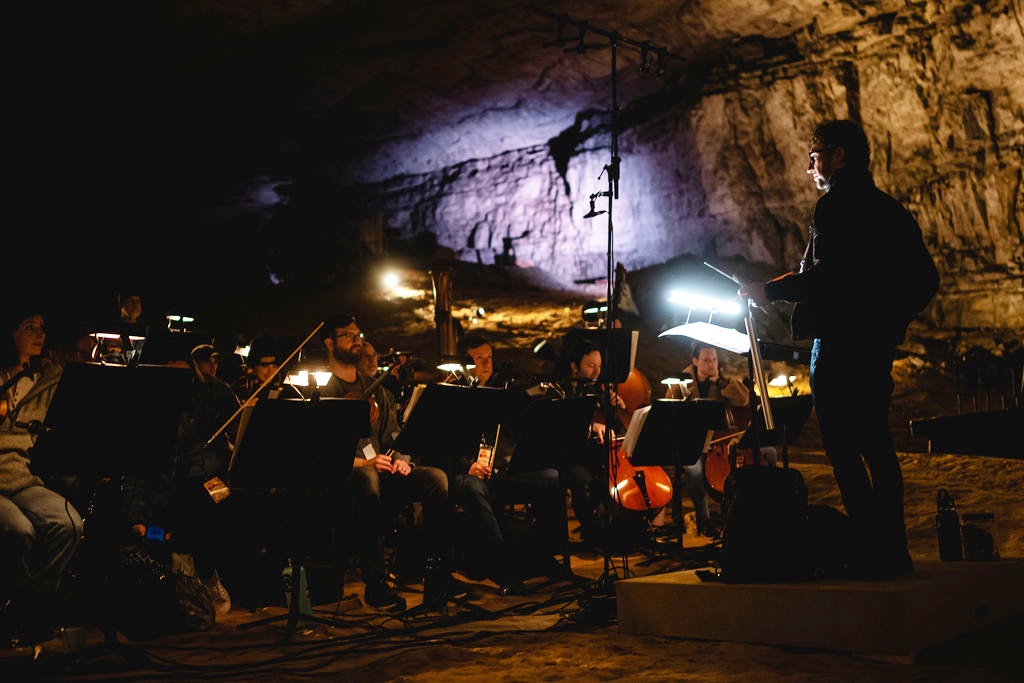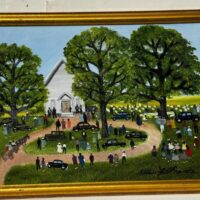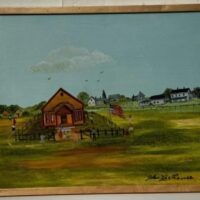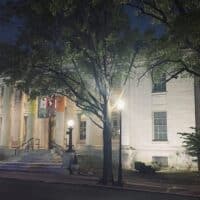April 29, 2023 was a monumental day at Mammoth Cave National Park. A years-in-the-making collaboration between Louisville Orchestra Music Director Teddy Abrams, world-renowned cellist Yo-Yo Ma, and the national park staff brought the world premiere of Abrams’ composition, “Mammoth,” to life. Two performances took place in a cave room called Rafinesque Hall, a short descent from the entrance.
As people gathered at the park visitor center, myself among them, there was an air of excitement, and of mystery. The opportunity to see Ma, to experience a site-specific musical composition, to hear a concert in an iconic cave, drew people to the park, but not many details about the event had been revealed.

“We really kept people in the dark,” said Graham Parker, chief executive of the orchestra. “We wanted people to pause their expectations and be open to what happens during the performance.”
Abrams’ manager, Matthew Oberstein, explained it this way: “Teddy’s approach is to find ways to connect people in a deeply impactful way, beyond what anyone might imagine in a concert experience.”
“Mammoth” was more theatrical performance than typical concert. A singer narrated as the celebrant, lighting created images playing off the cave walls, and sound effects reverberated throughout the space. The composition explored the natural, human, and mythological history of the cave and celebrated its other-worldly qualities. It was divided into five movements: Processional, Nature, People, Spirit, and Hymn.
I. Processional
A ranger led us on the gradual descent from the visitor center to the cave mouth. After climbing down a set of stairs, the cavern quickly narrowed and soon the cave roof was barely hovering over my head. A drum started beating rhythmically. Two singers entered the line next to me, singing in the style of a Gregorian chant. They ushered us into Rafinesque Hall with song.
The Louisville Orchestra has a history of innovation and a legacy of introducing new works by living composers. They have received 19 American Society of Composers, Authors, and Publishers (ASCAP) awards for adventurous programming in the use of contemporary music. Abrams fits nicely into that tradition; his list of compositions includes “The Greatest: Muhammad Ali,” a rap-opera about one of Louisville’s most famous sons.
Abrams has had a long fascination with Mammoth Cave. When he and Ma met in 2020 while recording a podcast episode, Abrams mentioned the idea of composing a piece to perform inside the cave, featuring Ma. The cellist agreed.
Abrams has spent countless hours in the last year immersing himself in Mammoth Cave. He has talked with rangers to learn the human history, and taken tours to understand the natural history. One park ranger commented that Abrams now knew the cave so well, he would qualify to lead tours himself.

II. Nature
A steady, melodic drip … drip from deep in the cave was a refrain throughout the entire performance. As the orchestra started playing, the strings plucked their own dripping sounds to amplify the natural pizzicato around us. The properties of the cave were a major element of the performance: “the pure blackout where you’re left with only your heartbeat, the cacophonous echoes of sound, the sensitivity of a pin dropping, the one light in the dark that can form a glow for us all to gather around …,” said Zack Winokur, theatrical director for the performances.
Abrams and Ma share a passion for bringing musical experiences to natural places.
In 2016, Abrams directed Oregon’s Britt Orchestra, accompanied by a Klamath tribe drum group, in a performance on the rim of Crater Lake. The original composition, “Natural History” by Michael Gordon, was commissioned to honor the centennial of the National Park Service.
Ma has launched his own project, called “Our Common Nature,” that is a multi-year celebration of the arts, and culture’s power to reinvigorate our connection to the natural world. He has already performed at other national parks, including the New River Gorge, the Grand Canyon, and Acadia.

Ma holds an expansive definition of culture: “It is how we create trust, wonder, faith, belonging,” he writes on his website about the project. “Culture helps us care for one another and for the world we share. It reminds us that nature is part of our humanity and that it contains an imagination greater than our own.”
III. People
The orchestra played echoes of the human presence in the cave over the last 5,000 years. First the music was a medley, then a cacophony — spanning different time periods, musical styles, and cultures. In the quiet that followed, we were invited to walk closer to listen to a story. Jerry Bransford, a fifth-generation cave guide, shared about his great-great grandfather, Matt Bransford, and his experiences as an enslaved man leading underground tours.
This concert was one more chapter in the human-cave story. It drew a diverse crowd. For some, it was their first orchestral concert. For others, their first visit to Mammoth Cave. The free tickets were awarded through a national park system lottery. Over 27,000 people from around the world entered for the 1,000 tickets. Attendees were 80% Kentuckians, 10% residents of neighboring states, and the rest from further afield.
The event was a powerful communal experience. While a film crew is creating a documentary, attendees had an awareness of being the privileged few to experience it in this way: a piece of music created after intense immersion in a place, designed to be played in against the sonic backdrop of the cave, telling a deep human story about this shadowy underground world.
IV. Spirit
Ma was our musical spiritual guide. He sat separate from the other musicians and played in conversation with them. His solo notes were full and rich. The cave did not create echoes; instead, the acoustics of the hall lent clarity and sensitivity to even his softest notes.
Abrams also considered the mythos and sacred nature of caves in his work. “From ancient mythology to modern fiction, caves have represented archetypical wonder and terror, symbolized the unknown, and served as the setting for our contemplation of the borders of life, death, and the great beyond,” he said.
Even today, Mammoth Cave harbors the unknown. It is the longest known cave system in the world, with 426 miles of mapped caverns and formations on five levels. Yet each year, its footprint expands with newly discovered passageways. According to the park website, explorers often say “there is no end in sight.”
V. Hymn
As the orchestra, one by one, walked away from their instruments and joined the choir singing in the center of the hall, I felt the final hymn in my chest, thrumming a tune of connection and hope. The cave intensified the musical vibrations, but also, we were a congregation, a colony of awe. The words, from “The Mammoth Hymn,” a poem written by Kentucky writer Wendell Berry, said, “To go in the dark with a light is to know the light. To know the dark, go dark. Go without sight, and find the dark, too, blooms and sings …”
As I lingered in the cave, soaking in the experience, I turned to the couple next to me. We had struck up a conversation earlier, so I knew they were spelunkers who volunteer regularly for cave clean ups. They venture into less-visited places in the cave, exploring it in ways hardly anyone else has. Even so, one said about the performance, “That made me see the cave in a new way.”

Beyond Mammoth Cave, an Orchestra Tours the Commonwealth
The “Mammoth” concert kicked off a two-year musical journey across Kentucky. “In Harmony – The Commonwealth Tour of the Louisville Orchestra” will stop in 20 towns, playing full orchestral concerts as well as more intimate performances in schools and libraries.
“With the ‘In Harmony’ tour, the Louisville Orchestra becomes the only orchestra in the United States committed to traveling to every corner of its state to partner in performance with artists across our communities,” Abrams said. “There is no so-called urban-rural divide in music. Art and music transcend geographic boundaries.”
Kentucky is primarily a rural state. The population is 4.5 million, but only two cities have over 100,000 people. Louisville is by far the largest with 633,000. Abrams’ ambitious vision of bringing music to people where they live was made possible by a budget appropriation from the Kentucky state legislature. Both Republican and Democratic representatives were champions of the project. This support enables the orchestra to offer all concerts of the “In Harmony” tour for free.
“We are going to places where it is likely people have not heard an orchestra before,” said tour organizer Arricka Dunsford. “We want to make sure everybody has access.”
The musical programs for the four legs of the tour will weave together traditional repertoire, popular music, and songs rooted in place. Even those who haven’t attended an orchestra before might recognize the “Sorcerer’s Apprentice,” the “William Tell Overture,” or the “Imperial March” from Star Wars.
An Eastern Kentucky portion of the tour will feature Tessa Lark, a violinist born and raised in Kentucky, playing arrangements of famous Appalachian fiddle tunes. The orchestra will also play a piece written by artist-in-residence Lisa Bielawa, composed after earlier visits to host communities. Programing in September includes mandolin virtuoso Chris Thile, another Kentucky native, performing the Kentucky debut of his own mandolin concerto.
The orchestra is intentionally creating a two-way collaboration with their rural host communities. In February, a bluegrass concert in Louisville will feature some of the musicians from these communities across the state. This rural engagement is an outgrowth of what the orchestra is already doing in its home city. The Music Without Borders initiative, funded by the city of Louisville, facilitates free concerts in underserved neighborhoods.
The “Mammoth” concert was a positive first step in bringing together urban and rural citizens. Louisvillian Kacey Harmeling is a huge fan of classical music and was thrilled to be at the concert. She is also a fan of the way Abrams sees the whole Commonwealth as his audience.
“I got choked up when I heard about the orchestra’s state-wide tour,” she said. “It’s fantastic. Kentucky is more than Louisville.”
This article first appeared on The Daily Yonder and is republished here under a Creative Commons license.
Kim Kobersmith lives in Berea, Kentucky. She has written extensively for the Daily Yonder about rural food, recreation, arts and culture, and development.






